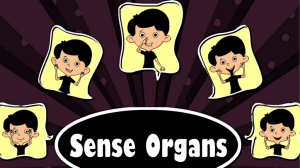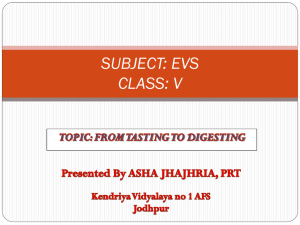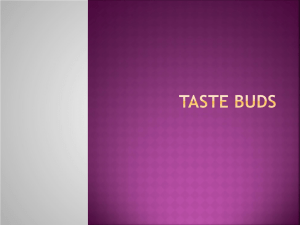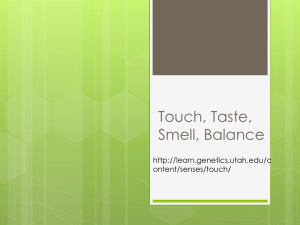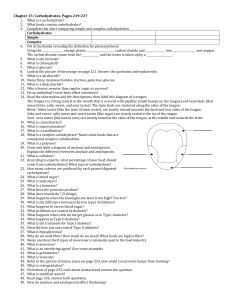TASTE EXPERIMENT- TONGUE MAPPING
advertisement
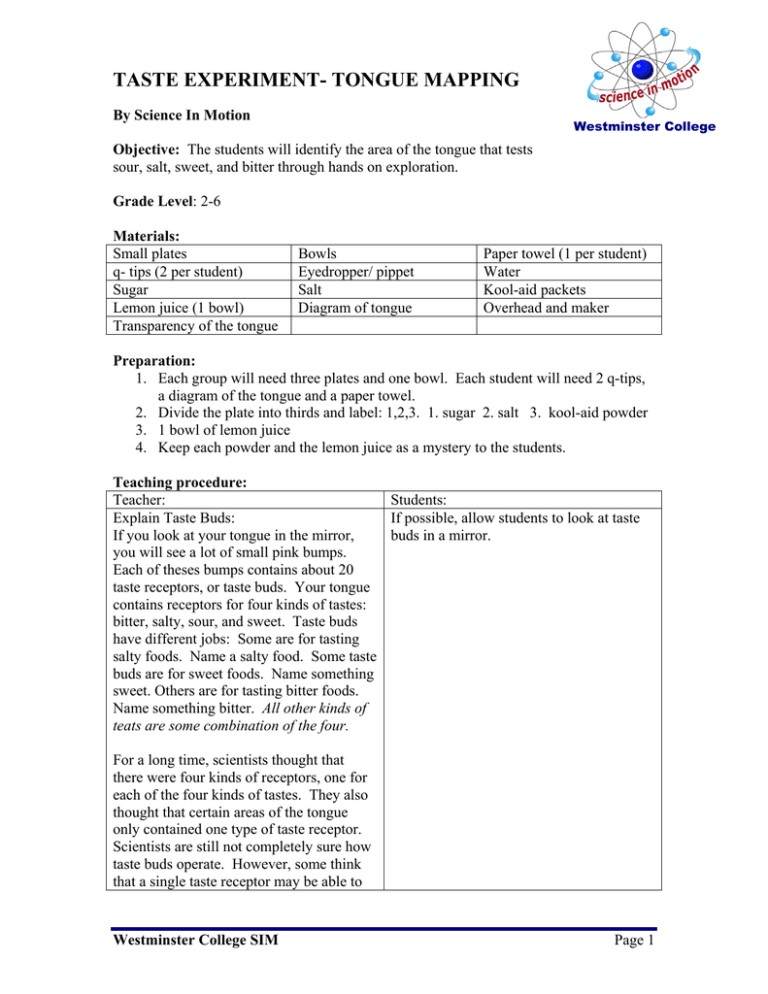
TASTE EXPERIMENT- TONGUE MAPPING By Science In Motion Westminster College Objective: The students will identify the area of the tongue that tests sour, salt, sweet, and bitter through hands on exploration. Grade Level: 2-6 Materials: Small plates q- tips (2 per student) Sugar Lemon juice (1 bowl) Transparency of the tongue Bowls Eyedropper/ pippet Salt Diagram of tongue Paper towel (1 per student) Water Kool-aid packets Overhead and maker Preparation: 1. Each group will need three plates and one bowl. Each student will need 2 q-tips, a diagram of the tongue and a paper towel. 2. Divide the plate into thirds and label: 1,2,3. 1. sugar 2. salt 3. kool-aid powder 3. 1 bowl of lemon juice 4. Keep each powder and the lemon juice as a mystery to the students. Teaching procedure: Teacher: Students: If possible, allow students to look at taste Explain Taste Buds: buds in a mirror. If you look at your tongue in the mirror, you will see a lot of small pink bumps. Each of theses bumps contains about 20 taste receptors, or taste buds. Your tongue contains receptors for four kinds of tastes: bitter, salty, sour, and sweet. Taste buds have different jobs: Some are for tasting salty foods. Name a salty food. Some taste buds are for sweet foods. Name something sweet. Others are for tasting bitter foods. Name something bitter. All other kinds of teats are some combination of the four. For a long time, scientists thought that there were four kinds of receptors, one for each of the four kinds of tastes. They also thought that certain areas of the tongue only contained one type of taste receptor. Scientists are still not completely sure how taste buds operate. However, some think that a single taste receptor may be able to Westminster College SIM Page 1 Taste Experiment respond to more than one taste. They think that the receptor might send information to the brain in more than one way, causing more than one kind of sensation. Explain experiment: The sweet, sour, salty, and bitter taste buds are all in the same area on your tongue. Today, your job is to find out were those taste buds are. Give each student 2 Q-tips and point out that each end is for a different mystery substance. Students start with the #1 mystery powder. When students are finished with the mystery powders. Get the mystery juice (lemon juice) for each group table. Check for understanding. Reveal the mystery substances: 1. sugar 2. salt 3. kool-aid 4. lemon juice See if students correctly identified the parts of the tongue with the taste buds. Westminster College SIM Each student receives 2 Q-tips. And has the mystery powder plate and a bowl of water in the middle of their groups table. Students dab their Q-tip in water and then in mystery powder #1. Then the students dab the Q- tip in the tip, side, and center of their tongue. Finally, they mark the area they tasted the powder on the drawing of the tongue. Students repeat above with the following mystery powders. Students repeat above with the mystery juice. Students can discuss within their group where they labeled the tastes. Students can write these mystery substances on their sheet. Tongue Mapping Answers: Page 2 Name______________________________ Taste Experiment Date__________________________ Tongue Mapping If you look at your tongue in the mirror, you will see a lot of small pink bumps. Each of theses bumps contains about 20 taste receptors, or taste buds. Your tongue contains receptors for four kinds of tastes: bitter, salty, sour, and sweet. Label #1, #2, #3, #4 for where you taste each mystery substance on your tongue. Mystery Substances Revealed! #1_______________________________________________ #2_______________________________________________ #3_______________________________________________ #4_______________________________________________ Westminster College SIM Page 3 Taste Experiment Westminster College SIM Page 4
